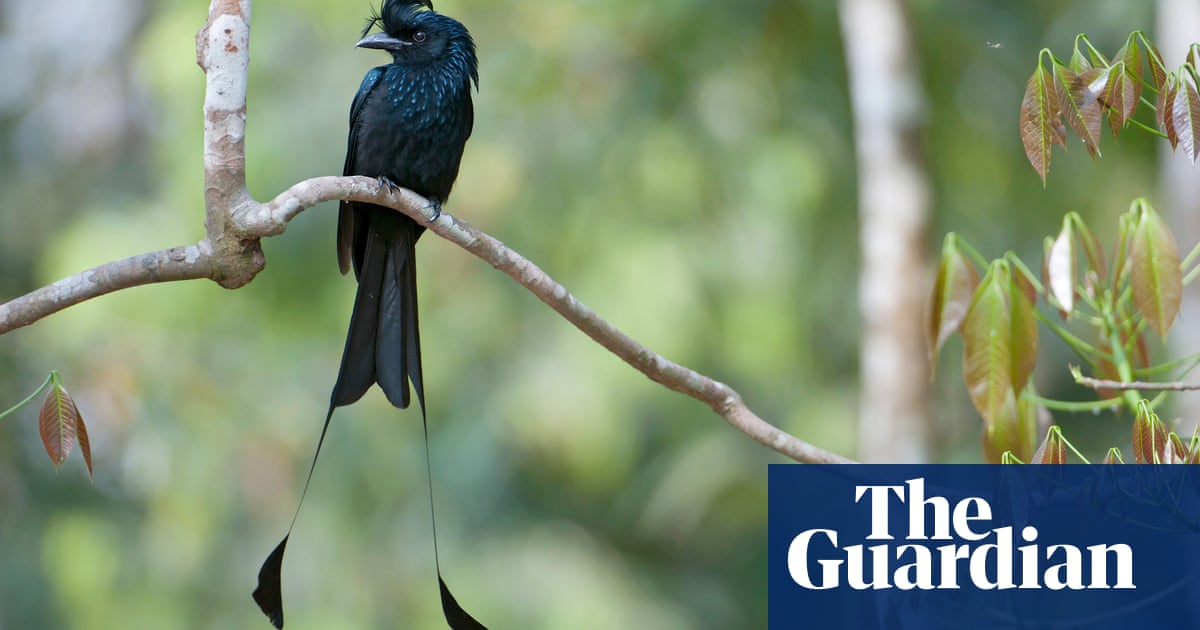
In the dense forests of south India’s Western Ghats, you may be lucky enough to spot a greater racket-tailed drongo crooning to birds of other species nearby. But the drongo is not singing. It is mimicking the other birds, according to ethno-ornithologist Samira Agnihotri.
With recording equipment in hand, trekking up to six miles (10km) a day through the forests, Agnihotri has been taping native birdsong for the past 18 years. Her favourite is this drongo, a bluish-black bird with an Elvis-like quiff and two very elongated tail feathers.
During her doctoral research at the Indian Institute of Science in Bengaluru, Agnihotri tried to find out why this species is such a mimic. Most species that imitate other birds only do so in the breeding season, but the racket-tailed drongo seems to do so year round.
“We know, from our observations of mated pairs defending nests, that both sexes mimic, but we don’t know more because males and females look alike – you can’t tell them apart in the wild,” she says.
Agnihotri found that the mimicry was used to attract mates, but also observed the bird using mimicry when it was threatened, especially when nesting, and when it was feeding alongside other bird species in what are called mixed hunting parties or mixed-species flocks.
Like most researchers who work in the forests of the Western Ghats, Agnihotri looked for help from an indigenous tribal community, the Soliga people, whose immense knowledge about the landscape helped her to track the drongo.
The Soliga have songs for many of the birds found in their forests which describe the behaviour of the birds, what they eat, their calls and more.
The drongo is called ko:luka:ra (rod bearer) – a title given to a Soliga elder responsible for maintaining peace and order – because of its ability to attract birds of other species into mixed flocks and its possible role in maintaining those groups.
Agnihotri started documenting the Soliga’s knowledge of birds in collaboration with Aung Si, a postdoctoral fellow in the linguistics department of Cologne University. “Birds are mysterious and magical creatures for many cultures, and this is definitely true for the Soliga as well,” says Si.
“In Soliga culture, birds act as portents of danger by warning travellers of dangerous animals, as observers of and commentators on human morality, as indicators of the passing of the seasons, and so much more.”
He added that the Soliga’s knowledge and deep connection with the forest made them perfect allies for conservationists.
“They are intimately aware of every aspect of their jungle home, and their everyday conversations are full of commentary on the health of the forest, the seasonal appearance of key organisms such as migratory honeybees, the movements of large mammals like elephants, or the local extinction of culturally important medicinal plants due to ecological change,” he says.
“It was an eyeopener for me,” adds Agnihotri. “It showed me that there exist other ways of perceiving and knowing nature that are different from ‘scientific’ knowledge – which is highly influenced by western systems – but equally rich and valuable.”
The overarching theme of the different research she now does is “listening ecology, with the aim of drawing attention to diverse voices – human and non-human – and in doing so, encourage people to listen more, to the sounds of nature around them and to each other.”
The Soliga language is, however, only spoken by a small, marginalised community. “Their distinctive ways of thinking and talking may be ignored or dismissed by speakers of larger, more powerful languages,” says Si.
The language and traditional knowledge that accompanies it could be lost to future generations. “That will be a big loss to not just the community, but to science and to the way we understand the world around us,” says Agnihotri.
Agnihotri is collaborating with the Soliga community to explore new ways to reach their youth using technologies such as YouTube and WhatsApp to document their traditional food, medicine, folklore, stories and songs.
“We are developing charts for Soliga sounds (since there is no script), and flowers, trees and animals,” says Agnihotri. “And we’re trying to make games that are interactive and appeal to children and youth about the traditional knowledge so they continue to be stakeholders of their knowledge systems and the forest which they call home.”
Indigenous knowledge has co-evolved with the wildlife around the communities, and can provide new insights for science and policy, says Agnihotri.
“We have a long way to achieve this in India, but there are many hopeful beginnings towards conserving the biocultural diversity of the country.”












